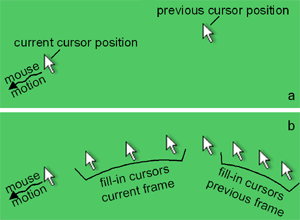high-density cursor
|
up patrick baudisch |
| high-dens. cursor try it out (flash)! video 34mb wmv publications |
| visitor |
|
Get the
Flash Player to see this player.
|
As bigger screens and multi-monitor configurations become more popular, users employ higher mouse accelerations in order to traverse the screen reasonably quickly. The faster the mouse cursor moves, however, the more it seems to jump from one position to the next, as it is updated only at the refresh rate of the monitor. This lack of visual continuity increases the risk of users losing track of the cursor. High-density cursor addresses this issue by filling in additional cursor images between actual cursor positions (temporal supersampling). Unlike existing techniques, such as the Windows mouse trail, the proposed technique preserves the responsiveness of the mouse cursor. In our user study high-density cursor improved participants’ performance on a Fitts’ law task by up to 7% for target acquisitions across long distances. Moreover, the conditions of the high-density mouse that were tested were subtle enough that they were often not even detected, and were never considered distracting.
|
|
Baudisch, P., Cutrell, E., and Robertson, G. High-Density Cursor: A Visualization Technique that Helps Users Keep Track of Fast-Moving Mouse Cursors. In Proceedings of Interact 2003, Zurich Switzerland, August 2003, pp. 236-243. |
